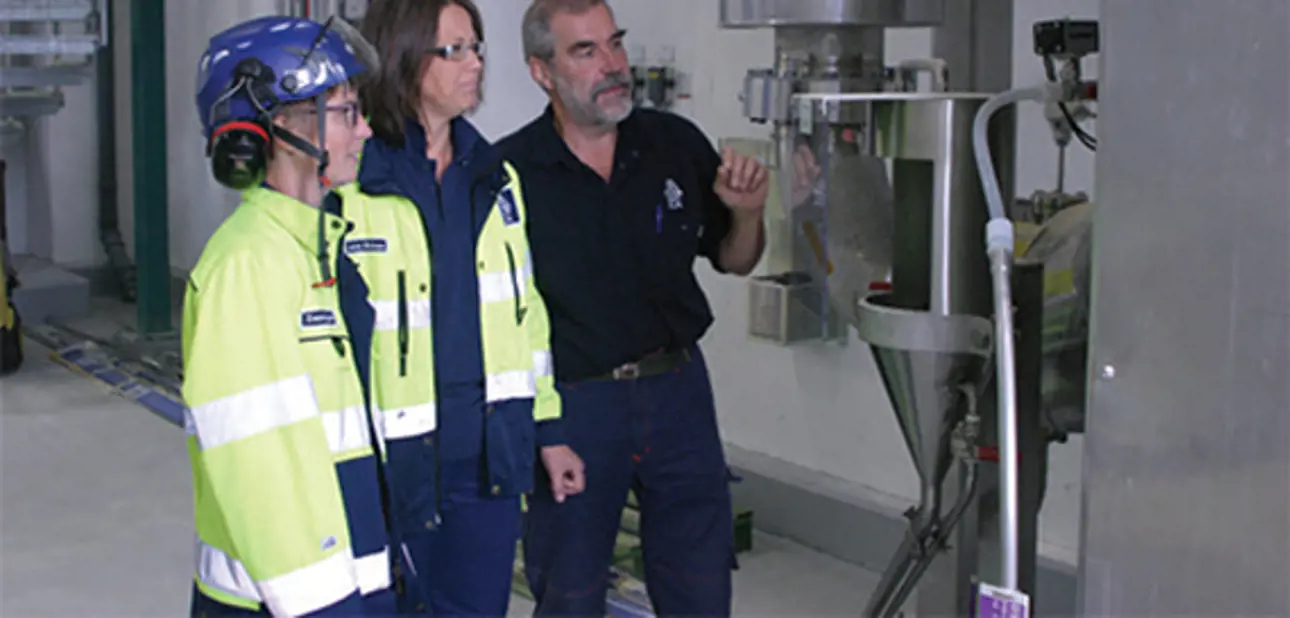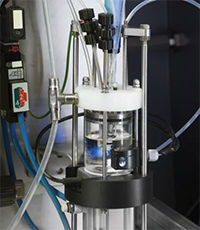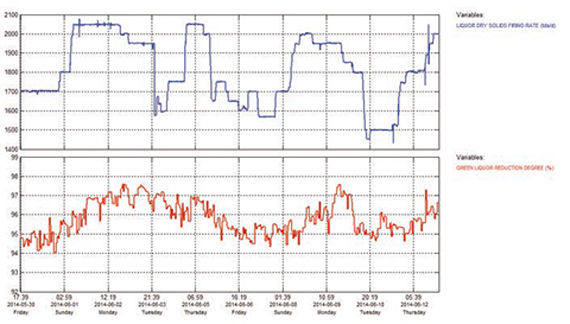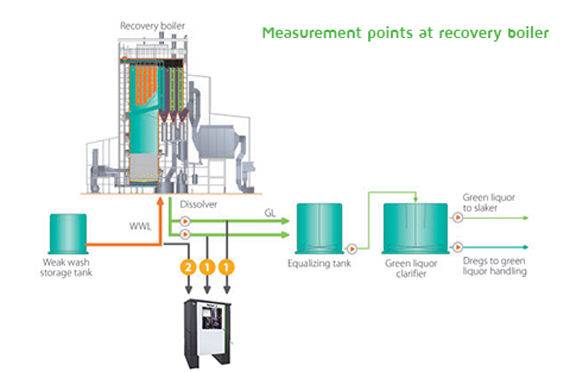Related links

Automatic on-line analyzers for controlling the kraft pulp mill causticizing operation have been in operation for more than 15 years now and their benefits have been well documented. It’s established technology, as Valmet counts more than 160 causticizing line applications worldwide with more than 600 sampling points. But as technology progresses there is always a need and a challenge to break new ground in measurement capabilities.
The new Valmet Recovery Liquor Analyzer, named Valmet Alkali R, does just that as it now completes the required chain of quality control measurements of the causticizing process from the smelt to white liquor and gives operators the tools they need to stabilize and optimize the entire process from the recovery boiler onward. It’s the final link. Now, with Valmet Alkali R, the first measurement point has been moved as far back as possible to the smelt dissolving tank where the reduction degree from the recovery boiler is measured. This is accomplished by a new titration module that measures sodium sulfate, complementing the previous capability to measure various alkalinity, sulfidity and causticizing efficiency parameters in the rest of the line according to the established ABC titration methods. As well as providing information for recovery boiler reduction management, this measurement also allows the precise control of dissolving tank green liquor density and TTA.
As with all new developments, the Valmet Alkali R analyzers were first tested in host mills, those being two kraft pulp mills in Finland. Those analyzers have now been taken into regular production use and operators follow reduction degree more frequently and make adjustments to maintain it. The first full-production unit was purchased by SCA’s Obbola, Sweden, kraftliner mill, where it has been performing well from day one, helping the mill to optimize the operation of a new causticizing plant since the startup in November 2013.

ROI potential
What extra capability for control and process optimization does this give operators and mill engineers? Antti Kokkonen, Valmet’s product manager for Valmet Alkali R, responds: “Since it does not react in the causticizing process, the sulfide generated in the boiler is the sulfide in the final white liquor. Therefore higher reduction degree means that less white liquor is needed to achieve the required alkali charge to the digester. Also, the amount of dead load accumulation in the recovery process can be decreased by improved reduction efficiency and this will improve energy and loading performance of the process equipment. This also enables higher energy production in the recovery boiler. In addition to that, there is lower lime demand at a given production rate, and with higher Na2S content the theoretical maximum causticizing efficiency is lower, which also decreases dead load if the mill is achieving reasonable CE% target.”
He estimates that a possible return on investment for a 1,000-tonne/day fiber line where reduction degree was increased by 3% could add up to Euro 1 million/yr. These gains are due to debottlenecking and production increases of over 1% in the causticizing plant, lime kiln, and evaporation plant and in energy savings in these stages.
Startup "One of the best"
While the other mills used the analyzer to improve the existing processes, the Obbola mill had it its own reasoning relating to the plant startup. “There were a couple of reasons for us to consider an automated sampling and analyzing system,” says Thure Sandström, manager of the recovery area. “As we were investing in a completely new causticizing plant we wanted to have a modern system improving work safety, as there are always safety issues in manual sampling, and more frequent process data to support the process operators. An important parameter was to have frequent data on the reduction degree.”
“Earlier, process operators took samples from five points of the process and thereafter analyzed the samples in a semi-automatic titration unit,” Annika Hedman, laboratory engineer, adds. “We could see that there were variations in the data obtained, variations that in many cases were due to who took the samples and analyzed them, and not due to process variations.”
The analyzer measures process parameters at five points using a central titration and analyzer module. The sampling points are green liquor after the recovery boiler at the dissolving tank, green liquor before the slaker, lime milk at the top of the slaker, white liquor after the last causticizing vessel and white liquor after the filtration. This final measurement is critical for accurate digester charging. The samples are automatically taken and fed to the central titration measurement unit. The unit runs through a prioritized sequence of titrations each taking a few minutes for the sample points in whole line. When this sequence is completed the reduction degree measurement is updated once per hour, meeting the customer’s expectations.
Sandström explains, “We wanted an online solution for measuring the reduction degree. Earlier the sampling frequency of 6 to 8 hours was not good enough as we needed reliable information quicker, down to a level of every hour, or every second hour, on the recovery boiler performance. This called for an automated solution. After evaluating different automated analyzing methods of the reduction degree, we felt most comfortable with the Valmet Alkali R solution, although it just had been introduced on the market.
“The start-up was one of the best I have ever experienced,” Sandström continues. “We installed the sampling and analyzing equipment during a production shut down. A couple of weeks later (after the shutdown) we took the system into operation and got reliable measurement data from the very first day.”
Stable analysis
“We could immediately see that the stability of the analysis results improved as we got rid of the variations due to different ways of taking the samples,” project leader Kristina Jonsson stresses. “It is of course important where the sampling points are. We managed to get the first sampling point immediately after the dissolving tank, which is as close to the recovery boiler as you can get. This sampling point is 200 metres away from the analyzer unit, which means that the sample stream is pumped outdoors in a heated tube to the analyzer, where the actual sample is taken for analysis.”
“The data achieved is displayed in our control system showing reduction degree, TTA, causticizing efficiency, sulfidity and EA, says Erik Henriksson, recovery boiler process operator. “If there is a deviation we can make a comment in the system’s log-book so that other shift teams can see what has happened and what has been done to correct it. As we have seen that the results from Valmet Alkali R system are very reliable, we are now focusing on fine tuning target values as well as limits for the reduction degree.”
“The system has proven to be very stable,” Hedman continues. “We add chemicals to the analyzer unit once a week. The reduction degree is manually checked once a month and we have found that to be enough. The shift operators check the system once every shift to make sure that there are e.g. no leakages or any other visual problem.” Valmet’s Kokkonen adds,” High uptime- typically more than 98% - for minimal maintenance is a core concept of the Valmet Alkali R design. There are preventive maintenance and troubleshooting information easily available at the analyzer’s touch screen interface and, more importantly, there is an intelligent self-diagnostics feature built in to the analyzer. Our availability guarantee is 98%. Furthermore, no calibration is needed at any point.”
Reliable tool
“With the new system we have learned more about how the recovery process, and in particular how the recovery boiler, performs,” Peter Olsson, manager, recovery boiler operation, adds. “Now we have a reliable tool for better process control and process understanding. We see a number of opportunities to optimize the recovery process as focus can be put on the recovery boiler and its performance. As we get the reduction degree values much more frequent, we can make sure that the recovery boiler runs stable. It is early days to say exactly how the recovery boiler performance will be optimized but with proven accuracy of the analysis result we will step by step optimise it further.”

In this chart, typical reduction degree variation due to dry solids firing rate is shown to operators. Data are from a Finnish kraft pulp mill.
“We noticed in the beginning that the increased frequency of analysis results encouraged operators to make quicker changes based on the latest result,” Sandström recalls. “This is however dangerous as if you start to change process parameters too often the result might be that the process gets out of your hands. We have therefore learnt not to make changes based on one single result but on an accumulated trend, which we get from the automated system. Earlier we measured the reduction degree every four hours and if the value wasn’t as expected we got a bit nervous knowing that we had to wait another four hours for the next analysis value. Sometimes we started to make changes believing that something could be wrong and sometimes we did nothing hoping that the value itself, and not the process, was wrong. Now, however, as we get frequent reliable data we can wait for a couple of reduction degree values until we know if a process change has to be done or not.” “An important reason for the investment was work safety,” Jonsson stresses. “Risks connected to manual sampling are now eliminated so the working environment is in this respect safer, which is very important to us. Changes in the recovery process are slow, which brings stability but it also means that it takes a long time to correct a downward trend in e.g. reduction degree before it is back to normal. During such a down period changes to counteract the effect of a lower reduction degree have to be done in the digesting plant, which increases the production costs as well as causes quality problems. As frequent analysis data now are available, downward trends are spotted early and corrections can be done much quicker making the recovery process more stable and hence the white liquor quality more stable.”

Valmet Alkali R measurement points at the smelt dissolving tank
Exceeded goals
Has the mill achieved their goals with this investment? Sandström responds positively: “We have not only achieved the goals, but also exceeded them. In all fairness, this is not only due to the automatic system but it is a combined effect of the new causticizing plant and the automated analyzing system. The whole white liquor production is more automated nowadays and its progress is frequently followed by the Valmet Alkali R analysis system. The process is followed in real time and hence we have a better control of what is happening."
“In the future we might add one or more sampling points in the chemical recovery plant, or even close the loop by letting the results from the automated measurement control the process. However, this is no priority at this point as we are focusing on learning more about the recovery boiler performance and how the whole recovery process can be optimized further,” he adds.
Approaches to control
The way to manage the recovery boiler variables to achieve the target reduction degree is now becoming apparent. Operators at one mill in Finland first try to set the char bed in a stable state and then by adjusting the air feeds they try to improve reduction. The reduction degree at this mill is 95-97% when on stable operation. The recovery boiler is being controlled by Valmet optimization control.
While these clients are looking at ways to utilize data from the analyzers to optimize reduction degree in their individual mills Valmet is putting together on-line process response data that would help to formulate a general approach to control reduction degree. Valmet representatives have recently presented these findings at the 2014 PAPTAC “PacWest” Conference in Canada and at the 2014 APPITA Conference in New Zealand. These papers look at the process responses associated with char bed building, liquor firing temperature and combustion air distribution. The results are published in the conference proceedings. To date, four analyzers with reduction degree measurement are in the process of commissioning.
For more information, please contact: Antti Kokkonen
antti.kokkonen(at)valmet.com
*) Company and product name Metso until March 31, 2015.
**) Original article published on PPI Magazine 02/2015
